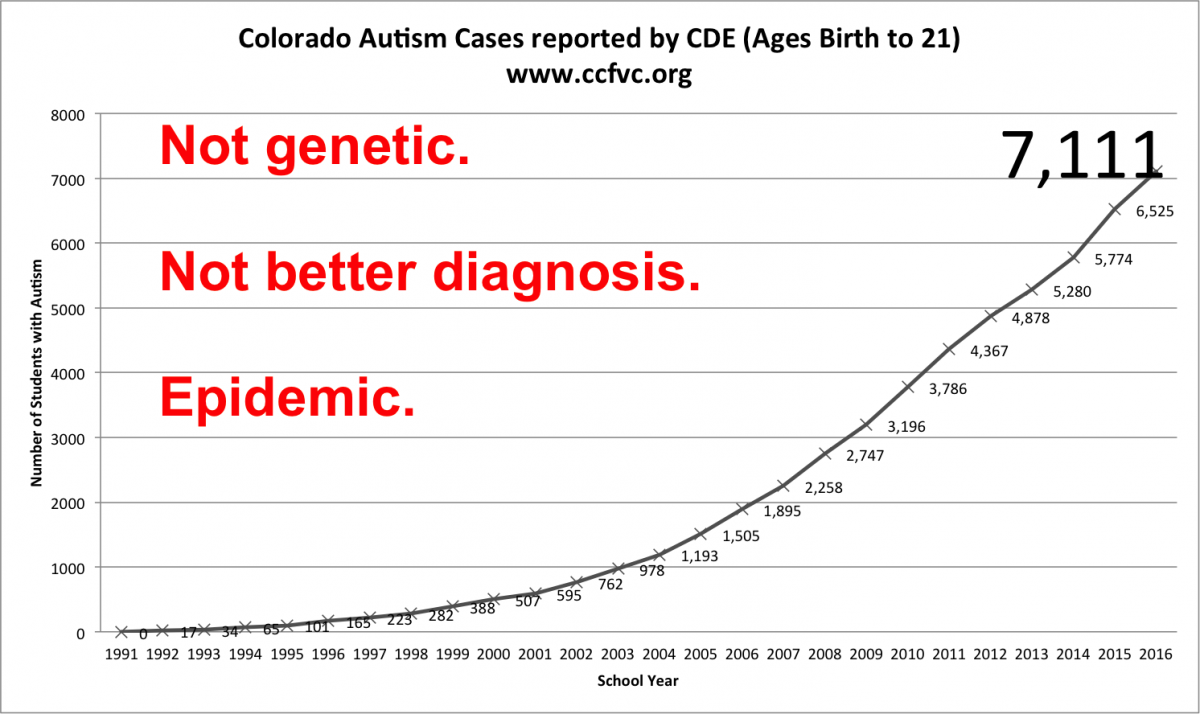By Pam Long
Colorado’s public health experts continue to promote the erroneous belief that an alarming increase in autism rates is due merely to better diagnosis. At the November 2017 Colorado Department of Public Health and Environment (CDPHE) Board of Health (BOH) meeting, Mr. Tony Cappello, from the Disease Control and Environmental Epidemiology Division at CDPHE, assured the Board that there has only been a mere 10% increase in autism prevalence. However, publicly available data from the Colorado Department of Education (CDE) shows an astonishing 41,729% increase in autism since 1992. A 41,729% increase in autism in one generation is a public health emergency.
FIRST CASE OF AUTISM IN 1992
In 1991 the CDE had recorded zero cases of autism in Colorado. In 1992 there were 17 cases, and as of 2016, there are 7,111 cases of autism in children aged 5-21. But even that nearly 42,000% increase in autism does not paint the full picture. In 2016 there were also 8,992 Preschool age children diagnosed with developmental disabilities, and 10,203 additional children with “Other Health Impairments,” which includes chronic health issues and a significant increase in ADHD, seizure disorders, and emotional disorders. Furthermore, this data does not reflect the 20% of children with autism who do not attend public school, nor any adults over 21 who have aged out of school services.
The State of Colorado is facing more than 33,000 cases of children with neurological injuries, developmental delays, and other health impairments. This is clearly the largest children’s epidemic of modern times.
NOT GENETIC. NOT BETTER DIAGNOSIS. EPIDEMIC.
These increases cannot be explained away by “better diagnosis” because most of these cases were diagnosed under the same criteria in the Diagnostic and Statistical Manual of Mental Disorders (DSM-IV) 2000. Furthermore, removal of the Asperger Syndrome subgroup in DSM-V 2013 did not result in a corresponding decrease in autism. Genetics cannot explain the increase of this size as genetics remain constant over time, and most of the affected individuals have no family history of autism. Autism is not an inherited condition as people with autism typically do not get married and have children. And even a substantial 48% increase in student population in Colorado from 1992 to 2016 cannot explain a 42,000% increase in autism.
The data supports only one conclusion: autism is a public health emergency caused by environmental factors. As the first children affected by autism entered preschool in 1992 at age 4, the new environmental variables introduced near their birth year in 1988 demand investigation. In Colorado today, one in every 92 children across every region and demographic group in the state is presently debilitated by this disease. The CDC declares an epidemic of influenza near 7.7 cases per 1000. Autism reached 7.5 cases per 1000 in Colorado more than ten years ago in 2006. In 2012, autism in Colorado reached 10.8 cases per 1000. Yet, CDPHE has still not declared an epidemic nor taken any action to mitigate this crisis.
GROWTH OF DEVELOPMENTAL DISABILITIES
The federal government made autism a special education category in 1991. And up until 1996, the CDC’s Metropolitan Atlanta Developmental Disorder Surveillance Program (MADDSP) reported only four (4) categories of developmental disabilities: mental retardation (low IQ), cerebral palsy, vision impairment, and hearing impairment. The 1996 MADDSP summary introduced autism as a unique new category at 3.4 cases per 1000. In 2000, as autism surpassed all other disabilities in prevalence, Autism Spectrum Disorders became a fifth category of developmental disorders for surveillance, and MADDSP became the multi-state Autism and Developmental Disabilities Monitoring (ADDM) Network. In 2017, there are now 14 categories of disabilities, affecting 10% of all students in Colorado.
2016 CDE DISABILITY DATA SUMMARY
| Intellectual Disability | 2,543 |
| Serious Emotional Disability | 5,474 |
| Specific Learning Disability | 39,022 |
| Hearing Impairment | 1,319 |
| Vision Impairment | 273 |
| Physical Disability | No report |
| Autism Spectrum Disorders | 7,111 |
| Traumatic Brain Injury | 524 |
| Speech & Language Impairment | 17,422 |
| Deaf-Blindness | 26 |
| Multiple Disabilities | 4,087 |
| Preschool Developmental Delay | 8,992 |
| Orthopedic Impairment | 443 |
| Other Health Impairment | 10,203 |
| COLORADO TOTAL 2016 | 97,439 |
COLORADO HEALTH DEPARTMENT IS DERELICT IN ITS DUTIES
By law, CDPHE has an obligation to monitor and report all chronic diseases, and yet autism has never been included in these annual state chronic disease reports. Rules and Regulations Pertaining to the Detection, Monitoring, and Investigation of Environmental and Chronic Diseases (6 CCR-1009-7) is the rule that specifically requires that CDPHE monitor, report, and investigate autism as a chronic disease. CDPHE records office and legal office jointly responded to a CORA records request that CDPHE has no records on statewide autism data from 1990-2017. CDPHE’s disability expert also responded that the CDC does not fund any autism data collection outside of the ADDM reporting sample from seven counties in Colorado, therefore there is no statewide autism data. Yet the educators at CDE can freely provide the statewide autism data for two decades by school year, school district, ethnicity, and gender. CDPHE’s response to autism is either apathetic at best or criminally negligent at worst.
For at least twenty years, CDPHE’s willful neglect of autism has been a total violation of public trust. How can the citizens of Colorado be expected to trust CDPHE on issues of public health when they intentionally ignore what can only be described as an epidemic? How is it conceivable that CDPHE collects annual detailed data on every child in the state, data on every disease including non-diseases such as obesity and tobacco use, data on every vaccine taken and not taken, and yet they have no data at all on the alarming growth of autism?
CDPHE IGNORES AUTISM’S $84,000,000 ANNUAL COSTS TO SCHOOLS
Parents of children with autism do not have the luxury to live in denial, and neither does the state of Colorado. During the past two decades there has been no accounting in CDPHE annual state reports on the financial costs of autism. There is an unsustainable billion-dollar statewide public health burden hidden in plain sight that is bankrupting Colorado’s schools and parents. As of 2016, there are more than 14,000 children affected by autism in Colorado. Each case averages $6,000 annually in additional local school costs, for a total state burden of $84,000,000 just in educational costs.
Additional other costs of autism per person per year include; up to $6000 for out of pocket medical expenses, $10,000 in medical expenses for Medicaid enrolled people with ASD, up to $60,000 in behavioral therapies not covered by insurance, $13,000 in special education expenses, and unknown dollar amounts in assisted living costs, as well as parents-as-caretakers’ lost productivity and wages. The financial impacts of the autistic population reaching and living through adulthood have not yet even been considered. The data discussed here does not begin to reflect the additional thousands of people over age 21 with autism, who have aged out of school.
CDPHE HAS KEPT LAWMAKERS IN THE DARK ON AUTISM
Our lawmakers have NEVER been briefed by CDPHE on the severity of the autism epidemic. Our lawmakers have no idea how many kids in Colorado have autism, how much and how fast the problem has grown, or what it costs from public health and societal perspectives. Some lawmakers may have been briefed by CDE regarding special education issues, only showing incremental growth of recent years, not the exponential growth from 1992. Colorado lawmakers and citizens have been purposefully kept in the dark.
I have found the precise autism statistic that will finally make the autism epidemic a priority: One child. When the transparency of this hidden data hits home with a state lawmaker’s child or grandchild, then they will start to see the invisible epidemic.
ACTION ITEMS FOR COLORADO RESIDENTS:
- Schedule an in-person or telephone conversation with your state Senator and Representative about the Colorado autism epidemic prior to the annual state departments accountability hearings on January 3, 2018.
- Demand that autism be declared a state epidemic, investigated as a priority in the 2018 legislative session, and given funding for an autism commission out of the existing CDPHE budget. Make CDPHE reprioritize.
- Demand that CDPHE leadership is held accountable for dereliction of duty.






